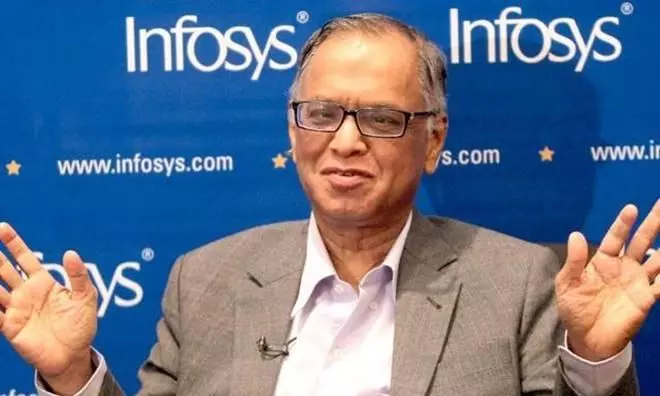
China abandoned 9-9-6 after workers' exhaustion: Should India emulate it?
Multiple studies show this 9-9-6 work culture, which Narayana Murthy advocates, has hurt Chinese workers and companies by adversely impacting their productivity, innovations, and competitiveness

Narayana Murthy, one of the founders of tech major Infosys, has given a series of TV interviews in the past few days advising Indian youth to follow the Chinese “996” work culture, or 72-hour work week. The “996” model culture refers to 9 am to 9 pm working day for six days a week.
This is one up on Murthy’s own 2023 advocacy for a 70-hour week – which had sparked widespread criticism from IT and HR professionals to trade unions. His motive is that Indian youth must work hard to build a $10 trillion economy. He said the youth must be inspired by the Prime Minister who works 100 hours a week at the age of 75.
China govt and top court declared ‘996’ illegal in 2021
Murthy is glorifying a work culture that Alibaba’s Jack Ma had famously called “a huge blessing” in 2019 – sparking huge backlash with Chinese state media slamming companies for making people work long hours.
Some experts have called that backlash “a tipping point” in China’s labour history that eventually led to the Chinese government and its apex court, Supreme People’s Court, declaring it “illegal” on August 26, 2021.
The Supreme People’s Court and the Ministry of Human Resources and Social Security (MHRSS) issued a stern joint warning to industry on that day, listing 10 court rulings on “illegal employment practices”. One of those involved job termination of a parcel delivery worker for refusing to comply with the company’s “996” policy; the court had ordered compensation of 8,000 renminbi ($1,238) for violating the labour law.
Also Read: Narayana Murthy renews call for 72-hour work week, cites China’s 9-9-6 model
The Labour Law of The People's Republic of China (2018 Revision) states (Article 36), “The State shall practise a working hour system under which labourers shall work for no more than eight hours a day and no more than 44 hours a week on the average.”
The joint statement said, “Complying with national working hours is the obligation of employers. Overtime can easily lead to labour disputes, impact the worker-employer relationship, and social stability.” It stressed on “protection of labourers' legitimate rights and interests”.
International agencies had reported then on extreme work pressures and low compensations leading to suicides and death from exhaustion, adding that millions of gig workers – couriers, food delivery riders, ride-hailing drivers – were facing greater difficulties in protecting their rights.
‘Modern labour slavery’
A joint study by universities of China and Australia, published on October 27, 2025, described “996” a “modern labour slavery”.
It said this practice was “common place in China’s digitech and internet sectors” and was directly linked to the rise in mental and physical problems like chronic occupational stress, burnout, mental health decline, and fertility postponement.
Also Read: 70 hours workweek? Narayana Murthy says he is all for it, but none should demand it
It found, workers often laboured long hours “without extra pay for those additional hours and are not always compensated in other forms”, posing “challenges of balancing innovation-driven growth organisations with employee well-being”.
The genesis
Two Chinese labour experts looked at the genesis of the “996” culture.
Published in 2023, it said “multifaceted and cumulative coercive effect” was at work since the introduction of neoliberalism in the late 1970s-early 1980s.
Also Watch: Watch | Why Narayana Murthy's 70-hour work week is unrealistic?
One is “informal-flexible-allied despotism” – top-down “informal” arrangement which brings “high risk of job loss and permanent unemployment” for workers refusing to comply with the “996” work schedule. Permanent unemployment is ensured through employers’ alliances aimed at eliminating job-switch.
The other is a “hegemonic mechanism” – to supplement the coercive controls – which sets “ideal worker norms” with rewards for more work, and striving and learning as keys to career goals.
Does ‘996’ drive innovation, productivity, or wage?
The Xiamen University, a top-grade Chinese public university with global standing, in its study published in March 2025 found that long working hours actually hurt China – in innovations and workers’ health and wellbeing (which lowers productivity).
It found “a significant inverted U-shaped” causal relationship between working hours and innovation output – that is, “working hours significantly improve innovation output (patent applications) during the initial stage, but when it exceeds a threshold of 8.89 hours, innovation output falls”. Thus, it eroded “enterprise’s value and competitive advantage”.
ILO study
The International Labour Organisation (ILO) study of October 2024 had looked at the China model to find that “long hours of work do not necessarily indicate high job quality” – that is, higher productivity.
It said when low wages were taken into account, longer hours “may actually reflect poor job quality” and explained, “For example, many low-income workers may work 50 to 60 hours a week but still struggle to meet basic living needs. This suggests that these jobs often lack adequate labour protections and benefits, forcing workers to extend their hours to make up for insufficient wages.”
Also Read: Watch: Will you work 12 hrs a day, 6 days a week? How practical is Narayana Murthy’s advice?
A 2023 ILO report had said, “Longer hours of work are generally associated with lower unit labour productivity, while shorter hours of work are linked with higher productivity.”
The ILO conventions benchmark 8-hour day and 48-hour week as “normal” working hours. So it is for wages.
All the studies and reports mentioned above point to long working hours’ association with low and exploitative wages going hand-in-hand with little or no overtime wages – even in formal sector firms which employ informal mechanisms to force workers into a “996” work schedule (as mentioned earlier).
The moot point is: Should Narayana Murthy be advocating this work culture?
